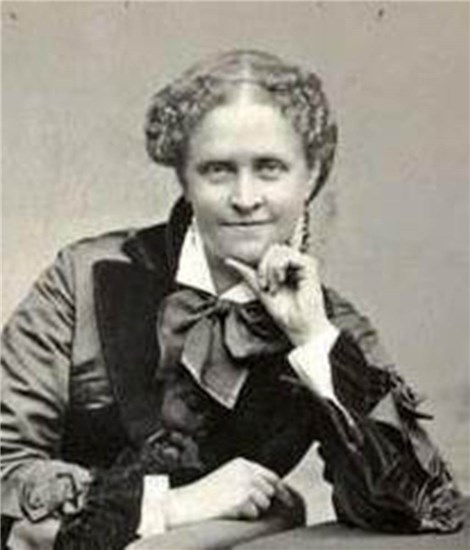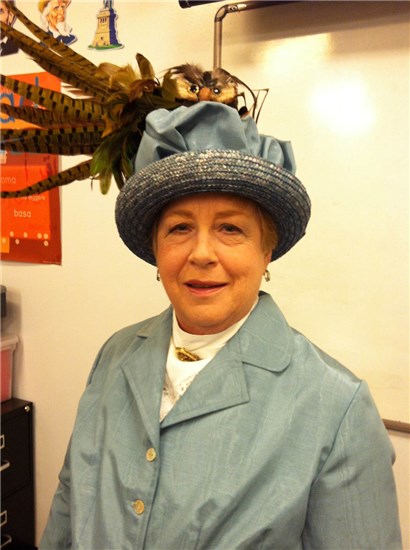

Helen Hunt Jackson (1830-1885)
by Gretchen Payne
Sponsored by High Plains Library District
Helen Hunt was already a well established and critically acclaimed author when she moved to Colorado Springs at age 43 in hopes that the dry air would heal her lungs of the consumption that had earlier taken her parents. As she recuperated, she began exploring the mountains to the west of her new home. She was especially enamored of the various plants and flowers that grew in the rarified air, and would always return home with armloads of the flora she discovered. She met William Sharpless Jackson, a banker and executive on the Denver and Rio Grande Railroad. They wed, and she continued traveling and writing essays, poems, and stories, but now they were about the West. Most of her previous works had been published in various periodicals (New York Independent, The Atlantic Monthly, Youth’s Companion), and she still contributed to those magazines, but of her 17 books, 15 were written after her move west.
Century of Dishonor: A Sketch of the United States Government’s Dealings with Some of the Indian Tribes was inspired by the speech of Chief Standing Bear she heard in Omaha, Nebraska, while attending a reception of the Omaha Indian Committee sponsored by the Herald newspaper editor, Thomas Henry Tibbles. She was ashamed that she previously knew nothing of the plight of the Indians and became caught up in the cause of helping them which consumed the rest of her life. She began researching other atrocities against the indigenous tribes and compiled her findings in this book which is still being read by historians while much of her other work has been largely forgotten.
The one exception is her novel, Ramona. Jackson had impressed President Arthur’s Commission on Indian Affairs, and she was named Special Commissioner to the Mission Indians in Southern California. While visiting there she came to the conclusion that she needed to appeal to the general public and realized that a serious book would not reach them. She decided to write a novel which she based on actual events but featured a heroine with a tragic love story in hopes of finding a sympathetic reading audience. She aspired to write a book that would raise awareness of the plight of the Indians much as Harriet Beecher Stowe had done for the slaves in the South.
Unfortunately Jackson did not live to see her influence. She died of stomach cancer shortly after Ramona was published. In 1887 the Dawes Act, the first American law to address Indian land rights was partially attributed to her. Ramona remained immensely popular with 300 printings, four film versions, a song, a TV series, and an annual outdoor pageant which still brings tourists to Southern California.
Recommended Reading
Hunt Jackson, Helen, A Century of Dishonor: The Classic Expose of the Plight of Native Americans. Dover Publications, 2003.
Hunt Jackson, Helen, Ramona. Signet Classics, 2002.
Hunt Jackson, Helen, and Mark I West, Selected Colorado Writings. Filter Press, 2002.
Gretchen Payne
Gretchen Payne is a retired high school English and speech teacher whose love of reading, history, and performance led her to join the Legendary Ladies. Coaching students in writing and oral interpretation has been an unexpected asset in this choice of post-career avocation. Her characters include Helen Hunt Jackson, Silver Heels, and Lady Catherine Moon. Since most history has been written by and about men, it is exciting to research and discover the strong, passionate, and influential women who helped frame our western culture.
Bullet Points
-
After author, Helen Hunt Jackson heard Chief Standing Bear speak, she made Indian Rights her goal in life.
-
Indian Rights advocate, Helen Hunt Jackson, wrote Ramona to call attention to the treatment of America’s natives.
-
Author, Helen Hunt Jackson, came West at age 43 and discovered her life’s passion as she fought for the rights of the Indians.
Quotes
“I contend the most odious thing in the world is to be a woman with a cause.”
“Of all my writings… nothing looks to me of any value except the words I have spoken for the Indians.”
“I shall be found with ‘Indians’ engraved on my brain when I am dead. A fire has been kindled within me which will never go out.”
“I’m going to write a novel, in which will be set forth some Indian experiences in a way to move people’s hearts. … People will read a novel when they will not read serious books.”
Timeline
1830 Born Helen Maria Fiske Amherst, Massachusetts.
1847 Helen orphaned at age 16.
1852 Marries Edward Hunt.
1853 Son Murray is born; he dies of a brain tumor before his first birthday.
1855 Son Warren Horsfield, is born; nicknamed “Rennie.”
1863 Edward dies in an accident involving a torpedo launching device he designed.
1865 Rennie dies of diphtheria, and Helen is left childless. Three months after Rennie’s death Helen’s first poem, “Lifted Over,” is published in Nation
1873 Doctors recommend she moved to Colorado Springs where the drier air would help her lungs heal from consumption
1875 Helen marries William Sharpless Jackson and becomes Helen Hunt Jackson. She continues to write travel essays, but now she is writing about the beauty of the West.
1879 Attends a reception of the Omaha Indian Committee, hears Standing Bear speak. She begins to research atrocities against the Indians.
1880 Jackson publishes her book, Century of Dishonor, and has a copy sent to President Arthur and every member of congress at her own expense.
1881 The President’s Commission presents a report favorable to the Indians. Jackson is “jubilant” and feels her work has been worth the effort.
1882 Jackson is appointed Special Commissioner and reports on the condition of the Mission Indians.
1884 While waiting for "Ramona" to be published, Jackson falls down the stairs at her home andbreaks her hip. She is confined to a wheelchair, but it doesn’t stop her from traveling.
1885 Helen Hunt Jackson dies of stomach cancer in a boarding house in San Francisco, California. Her husband has her body returned to Colorado, and she is buried beneath a cairn of stones on the northern slope of Cheyenne Mountain within the sound of the Seven Falls. Another falls nearby is named for her.